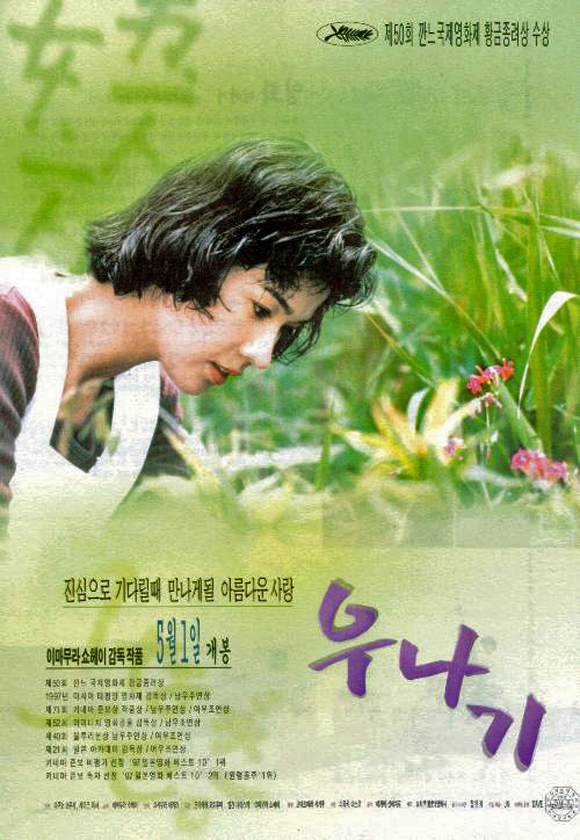Two Movie Reviews: ‘Unagi’ & ‘Stoker’
Unagi (The Eel)
Shohei Imamura, 1997
Coverage of the last Cannes Film Festival with all its Cote d’Azur glamour and boulevards teeming with cinematic talent left me pining for films, diamonds and a red carpet gown. The yen is not currently particularly conducive to the latter two, so I had to sate my hunger with films. As a bit of a Francophile I am desperate to see this year’s Palme D’Or winner Blue is the Warmest Colour, but as there’s no release date for Japan I suspect I have a long wait ahead of me. This disappointment however, has led to my new personal challenge: to watch as many Palme D’Or winners as possible.
The festival’s most prestigious award was introduced in 1955, so that’s quite a hefty list of films. Where to begin? Scrolling down Wikipedia’s handy list for inspiration I was able to pat myself on the back for having seen a fair few already, before spotting the works of a few distinguished Japanese directors. Shohei Imamura, the only Japanese director to receive the accolade twice, seemed an appropriate starting point for my filmic forage.
After Imamura’s The Ballad of Narayama took the Cannes top spot back in 1983 he came back, at the ripe old age of 71, and did it again with The Eel in 1997, becoming only the fifth director to win the Palme D’Or twice (there have since been two more).
The Eel opens with a quintessential Tokyo salary man, Takuro Yamashita, as he commutes home, the poisonous words of an anonymous letter describing his wife’s extramarital affair ringing in his ears. Upon his return, his seemingly dutiful wife sends him off on his usual night-fishing trip with his bento. However, suspicions piqued, instead of returning the next morning as planned Yamashita comes home in the dead of night, catching his wife in flagrante with a mystery man. The mood shifts sharply as Imamura portrays a very violent murder. But don’t let the gruesome opening sequence put you off or you’ll miss a sensitive portrayal of Japan’s everyman coming to terms with life after love, betrayal and loss.
Despite the initial scenes, The Eel is, on the whole, gently paced, picking up with Yamashita after eight years in prison for the crime he immediately turned himself in for. The film follows our now near-catatonic, uncommunicative protagonist’s gradual, if unconventional, opening up to emotion and human connections. The change is catalyzed by the new woman in his life, whom he saves from suicide only to have her repay him with initially unwanted assistance in his barber shop. Intriguingly the same actress, Misa Shimizu, plays both the adulterous murdered wife, and the convict-turned-barber’s assistant, Keiko Hattori.
From the mentally unstable Carmen-obsessed grand-dame (mother to Keiko) to the neighbour making a landing site for UFOs, the small cast is rich with characters. This enables Imamura to portray the passions and idiosyncrasies hidden beneath the orderly surface of Japanese society. By calling Japanese conformity into question, the spectator can contemplate the emotional issues which transcend nationality: jealousy, rage and remorse, but most importantly the endurance of hope and potential for redemption through love.
Although the rhythm of the film is generally as calm as the meandering river in which Yamashita goes nocturnal eel-fishing, Imamura shifts the tone from violence to farce, often by way of visually very 90s, and sometimes graphic, dream-like sequences. All of this can be rather disconcerting, contrasted as it is with the muted tones, discreet dialogues and repressed emotions featured in the majority of the film. However, Imamura uses this diversity to focus the spectator’s attention with precision on the flaws of mankind.
A film which includes adultery, murder, suicide, mental instability, physical assault, fortune stealing and prison internment may sound like the recipe for a good thriller. Thanks to expert directing and casting, The Eel is instead a sensitive, if tense, portrayal of the paralyzing stubbornness suffered by those who shield themselves against love following betrayal and pain.
And the title? Naturally it refers to the pet Yamashita raised in the prison pond; the only one who listens to what he has to say, and doesn’t say what he doesn’t want to hear…intrigued? You should be.
Charlotte Griffiths
Stoker
Park Chan-wook (2013)
Â
 Whilst I generally err towards more light-hearted fare when it comes to movies, I won’t deny having a soft spot for Park Chan-wook’s Oldboy. I may have only considered watching it because I wanted to see the live octopus scene, but it turned out to be a pretty entertaining, if somewhat violent, movie. The Stoker screenplay was looked at with a great deal of interest when it made its way onto the scene in 2010, and when Park took it on as his English language debut, the buzz around it really started to grow.
Whilst I generally err towards more light-hearted fare when it comes to movies, I won’t deny having a soft spot for Park Chan-wook’s Oldboy. I may have only considered watching it because I wanted to see the live octopus scene, but it turned out to be a pretty entertaining, if somewhat violent, movie. The Stoker screenplay was looked at with a great deal of interest when it made its way onto the scene in 2010, and when Park took it on as his English language debut, the buzz around it really started to grow.
I first came across the movie in September last year when the trailer was posted on the Empire Magazine website. It looked intriguing and beautiful; being easily swayed by others’ expectations, I was excited. After the film’s positive reception at Sundance, where it premiered in January, I was delighted to find that it was not only coming out in Japanese cinemas, but would be doing so in less than 6 months (which seems to be the normal wait time, if a movie comes out at all…). Opening weekend rolled around and it was off to the cinema!
Side note – it was randomly being shown in the Premier screen at the Toho Cinema in Nishinomiya Gardens, but for no extra cost. That was a good perk – as is going to Toho Cinemas in general because they have ginger caramel popcorn.
From the opening scene, it was clear that this was indeed going to be a visually beautiful movie. With slow motion close-ups of crops swaying in the breeze, our heroine, India (Mia Wasikowska) introduces herself in restrained voice-over before we are transported to the day of her eighteenth birthday and death of her father. Not exactly the best of birthday presents. At the subsequent funeral, India’s previously unknown uncle, Charlie (Matthew Goode), makes an appearance, and is invited to stay at the family home by her mother (Nicole Kidman). Together, the three form a triumvirate of ever so slightly crazy characters caught in a web of intrigue, hostility, lust and secrets.
Stoker is definitely one of the most precise movies I have ever seen. I think this is part of what gives the movie such a dreamlike quality. The characters seem detached from their actions and almost scientific in their observation of the world around them. The occasionally graphic scenes sit quite oddly next to ‘normal’ goings on and somehow take away some of the horror that’s occurring. The characters’ reactions, or rather lack thereof, further heighten this feeling. This is quite unsettling when, as audience members, we tend to base our own reactions to events on those of the characters. I frequently felt unsure about how I was meant to respond to what was happening and that was very discomforting.
Maybe I was in the wrong mood that day as I’m almost disappointed in myself for not liking the movie. It’s easy to see why it was so popular with ‘movie people’; symbolism abounds, the performances are immaculate and the psychotic horror of the story contrasts brilliantly with the visuals. That said, the story itself is quite predictable and whilst the characters are interesting as studies, I felt little investment in them. I would truly love to explore the layers to the movie that Park has woven together, but I just don’t want to watch the movie again in order to do so. I will accept that for other people, this may be an outstanding piece of writing and cinematography. Personally, I’d rather watch something else.
Imogen Custance



